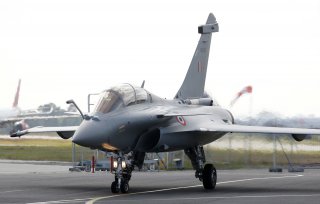Why India's Military Isn’t Getting the Weapons It Needs
New Delhi's labyrinthine procurement organization is an obstacle to the country's national security. And the external security threats that India confronts, especially that from Beijing, will not miraculously disappear.
The first five of the thirty-six Dassault Rafale fighters that India purchased from France reached Ambala airbase in the north Indian state of Haryana at the end of July. Air Chief Marshal Rakesh Kumar Singh Bhadauria, the chief of staff of the Indian Air Force, was on hand to greet the pilots who flew them from Merignac, France. Their arrival was also met with banner headlines in the Indian press. Two of these five aircraft were trainers and that they were purchased in 2016 and there wasn’t much of a public discussion of the fact that the original tender to acquire them had been launched in 2000 or that the initial request had been for 126 medium multi-role combat aircraft. It’s important to note that these five aircraft arrived in late July owing to an urgent request for their expedited delivery following a series of border clashes with the People’s Liberation Army forces along the disputed Himalayan border over the past two months.
The excruciatingly slow process of the acquisition of these aircraft is emblematic of the structural flaws that bedevil India’s defense procurement process. It is so dilatory, cumbersome and protracted that it may well imperil India’s national security. Sadly, the saga of the Rafales is just one example of the ongoing problems that afflict India’s weapons induction process. A range of other weaponry, which the Indian armed forces urgently need, remain trapped in bureaucratic bottlenecks.
For example, the inability of the Indian Air Force to procure six flight refueling aircraft in a process that has now run for fourteen long years. To wit, the Airbus A330 multi-role tanker transport has been shortlisted twice with the request for proposal to be eventually withdrawn. In 2018, the Indian Air Force published a request for information again with Boeing’s KC-46A joining the fray along with Airbus. However, budgetary constraints will most likely see India leasing such a capability, something that has been provisioned in the 2020 iteration of the Defence Procurement Procedure.
Yet another case of India’s broken defense acquisition system involves the Indian Navy’s indigenously-built French Scorpene-class submarines which are being inducted without their primary weapon: torpedoes. India canceled its plans to buy Black Shark torpedoes produced by WASS (Whitehead Alenia Sistemi Subacquei), as the parent company subsidiary Augusta Westland, was blacklisted in a helicopter bribery scam. With no alternative in sight, the Navy now relies on a handful of obsolescent German surface-and-underwater target torpedoes on India’s four Howaldtswerke-Deutsche Werft Shishumar-class vessels.
What explains India’s inability to streamline this process given that the country faces a significant security threat from the People’s Republic of China as well as to a lesser degree from its nettlesome neighbor, Pakistan? The labyrinthine procurement organization which constitutes of the Ministry of Defence, Service Headquarters, the Integrated Defence Staff (now headed by the new Chief of Defence Staff) and the vast array of laboratories under the aegis of the Defence Research and Development Organisation have seen little or no procedural reforms, changes in institutional structures or increased accountability.
The Ministry of Defence periodically releases a Defence Procurement Procedure, which emphasize indigenous production and procurement of weaponry. However, each iteration does little to address the cost premiums or potential decrease in output in implementing high levels of localization. The latest iteration of the Defence Procurement Procedure released last week continues to ignore India’s lack of core sub-systems manufacturing capabilities.
India’s inability to streamline its arms procurement process has led to a constant dependence on government-to-government defense purchases as well as a resort to “Emergency Procurements.” This a compelling testimony to the failure of the present procurement system to acquire much-needed weaponry in an open competitive process in a timely fashion.
Sadly, the external security threats that India confronts, especially that from the People’s Republic of China, will not miraculously disappear. In the absence of a dramatic reorganization of the country’s unwieldy defense procurement mechanisms, its national security will remain acutely vulnerable to extant threats for the foreseeable future.
Sumit Ganguly is a Distinguished Professor of Political Science at Indiana University, Bloomington.
Pushan Das is Head of Forums at the Observer Research Foundation in New Delhi. He tracks & analyzes issues related to Indian military modernization & foreign policy. Follow him on Twitter @Pushan3012.
Image: Reuters

